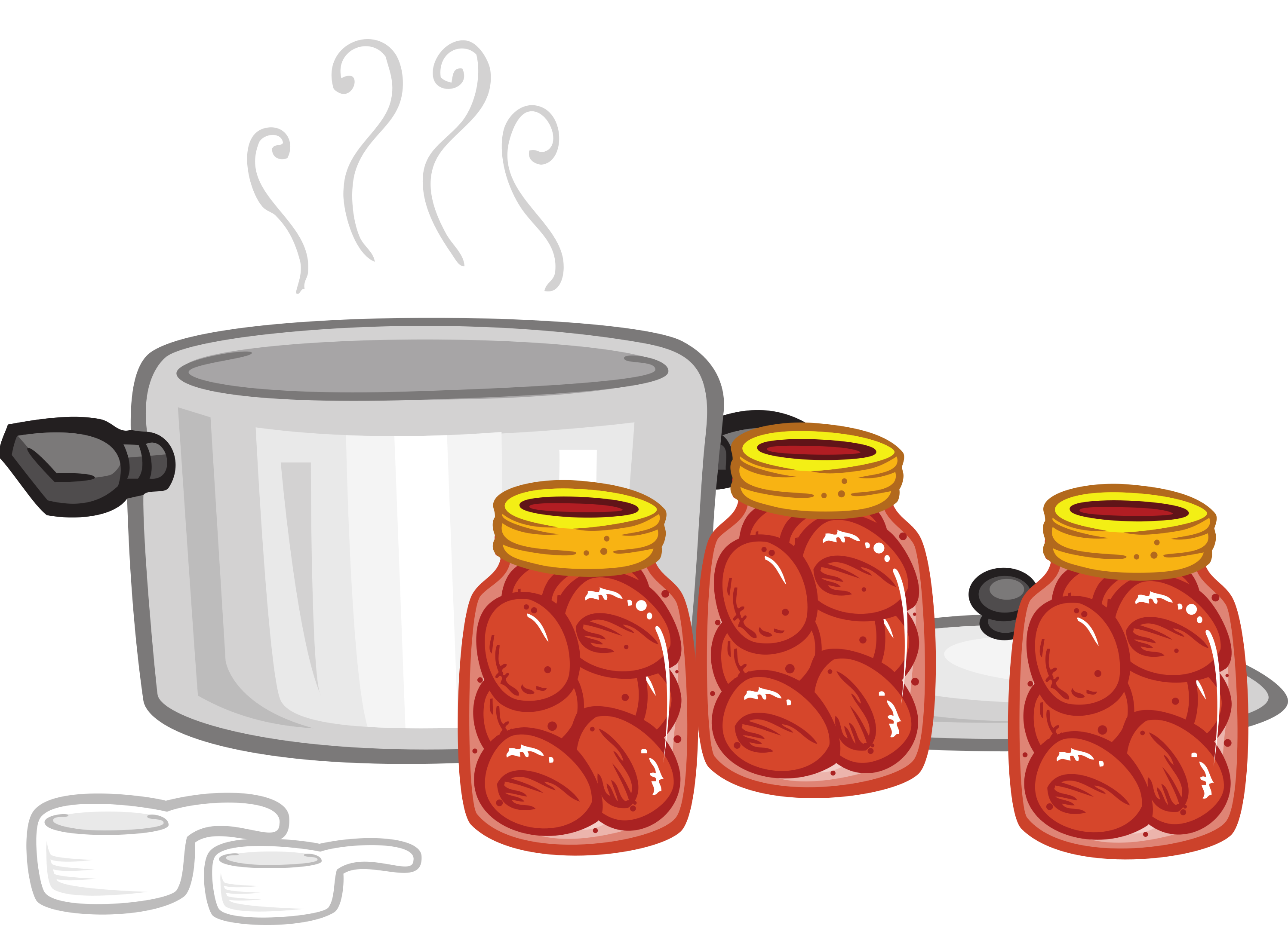Canning Tomatoes & Tomato Products
FNH-00171 View this publication in PDF form to print or download.
Ripe, red tomatoes are a welcome sight in Alaska. Because the storage life of fresh tomatoes is short, many people look for ways to preserve them for year-round meals. Home canning is one of the most popular methods.
When processing tomatoes, follow research-based recipes exactly to ensure a safe product.
Using the proper method and ingredients ensures that microorganisms that cause spoilage
(molds, yeast, bacteria) are destroyed by heat processing.
First, note the method to be used for canning, based on the equipment called for by the current research based recipe. Some tomato products may be canned in a water bath canner; others require the use of a pressure canner.
Second, select only disease-free, preferably vine ripened, firm tomatoes for canning. Green tomatoes are more acidic than ripe ones and may also be used. Do not use decayed or overripe tomatoes or tomatoes from dead or decaying vines.
Third, do not add or change ingredients; this can affect acidity (pH) and make the product unsafe. Added vegetables may cause an unsafe drop in the acidity of the product. Leaving out the lemon juice or citric acid can also affect the acidity and cause spoilage. Products that are not prepared according to a research-based recipe should be frozen.
Some cultivars commonly grown in Alaska and their pH values are listed at the end of this publication; you can see how lemon juice and citric acid affect pH. If you have questions about your tomato variety, contact your local Extension agent.
Preparing Tomatoes
Wash tomatoes in cool water. Remove skins by dipping whole tomatoes in boiling water for 30 to 60 seconds or until skin splits. Place in cold water, then slip off skins and remove cores. Trim off any bruised or discolored portions.
General Canning Instructions
Tomatoes can be canned using either the raw-pack or the hot-pack method. In the hot-pack method, hot food is packed in very hot jars, then covered with boiling liquid. In the raw-pack method, raw food is packed in very hot jars and covered with boiling water or juice.
For tomatoes, the hot-pack method has some advantages over raw-pack method. Heated tomatoes are easier to pack because they are softer, allowing for a tighter pack in each jar. In addition, tomatoes that are hot-packed float less.
Pack tomatoes in the jars leaving ½ inch of headspace. If the jars are too full, some of the contents could bubble out and interfere with the sealing process. After packing, run a plastic spatula around the inside of the jar to remove air bubbles.
Wipe jar rims and threads with a clean, soft, damp cloth to remove bits of food that might prevent a seal. Follow manufacturer’s directions for preparing lids. Screw rings on until fingertip tight.
Processing in a water bath canner:
- Fill the canner half full with very hot water. Heat the water to 180 ̊F.
- Arrange filled jars fitted with lids on the rack. Water should be 1 to 2 inches above the jars. Add boiling water, poured between the jars to avoid breakage if needed.
- Put lid on the canner and turn heat source to high.
- After the water comes to a boil, set a timer for recommended processing time. Keep water boiling gently. Add additional boiling water if necessary to keep jars covered.
- Remove jars from canner when processing time is complete, being careful not to tilt them.
- Put the jars on a rack or a cloth to allow for air circulation. Allow to cool for 12 to 24 hours before disturbing.
- Remove the rings and clean jars. Label with the date and contents. Store in a cool, dry place.
Processing in a pressure canner:
- Have 2 to 3 inches of hot water in canner on burner.
- Place filled jars fitted with lids on rack inside the canner.
- Fasten canner lid securely. Turn the heat setting to high.
- Watch for steam to escape steadily from the vent. When steam has escaped for 10 minutes, put dead counterweight or weighted gauge on canner vent port, or close the petcock. When correct pressure is reached, set a timer for the recommended processing time.
- Watch the canner to make sure the pressure stays constant. Adjust the heat under the canner to maintain a steady pressure at or slightly above the correct gauge pressure.
- When the time is up, remove the canner from heat. Allow pressure to drop naturally. When pressure drops to zero, remove the weight. After 10 minutes, unfasten the cover and remove jars.
- Put the jars on a rack or a cloth to allow for air circulation. Allow to cool for 12 to 24 hours before disturbing.
- Remove the rings and clean jars. Label with the date and contents. Store in a cool, dry place.
Recipes
Here are some commonly used recipes that are research based. These will result in high-quality, safe home-canned tomatoes.
All recipes are from So Easy To Preserve, Cooperative Extension Service, University of Georgia.
If processing at an elevation higher than 2,000 feet, contact an Extension agent for correct timing.
Crushed Tomatoes
Hot pack: Plan for 2¾ to 3½ pounds of tomatoes for each quart of canned tomatoes.
Start by quartering peeled and cored tomatoes. Heat about 1 pound of the quarters quickly in a large pot, crushing them with a wooden mallet or spoon as they are added to the pot. This will draw off some juice. Continue heating the tomatoes, stirring to prevent burning. Once the tomatoes are boiling, gradually add remaining quartered tomatoes, stirring constantly. These remaining tomatoes do not need to be crushed; they will soften with heating and stirring. Continue until all tomatoes are added, then boil gently 5 minutes. Add to hot jars:
- Bottled lemon juice: 1 tablespoon per pint;
- 2 tablespoons per quart or
- Citric acid: ¼ teaspoon per pint; ½ teaspoon per quart
Add ½ teaspoon salt to each pint jar or 1 teaspoon to each quart jar, if desired.
Sugar may be added to mask a sour flavor (½ teaspoon per pint or 1 teaspoon per quart)
Fill jars immediately with hot tomatoes, leaving ½ inch headspace.
Remove air bubbles with a spatula. Wipe jar rims. Adjust lids and process.
Option 1: Process in a boiling water bath:
- Pints 35: minutes
- Quarts: 45 minutes
Option 2: Process in a dial-gauge pressure canner at 11 pounds or in a weighted-gauge pressure canner at 10 pounds pressure:
- Pints or quarts: 15 minutes
Stewed Tomatoes
(about 3 pint jars)
- 2 quarts tomatoes, peeled, cored and chopped
- ¼ cup chopped green peppers
- ¼ cup chopped onions
- 2 teaspoons celery salt
- 2 teaspoons sugar
- ¼ teaspoon salt
Hot pack: Combine all ingredients. Cover and cook 10 minutes, stirring occasionally to prevent sticking. Pour hot tomatoes into hot jars, leaving ½ inch headspace. Remove air bubbles. Wipe jar rims. Adjust lids and process.
Process in a dial-gauge pressure canner at 11 pounds pressure or in a weighted-gauge pressure canner at 10 pounds pressure:
- Pints: 15 minutes
- Quarts: 20 minutes
Seasoned Tomato Sauce
(about 5 half-pint jars)
- 10 pounds tomatoes, peeled, cored and chopped
- 3 medium onions, finely chopped
- 3 cloves garlic, minced
- 1½ teaspoons oregano
- 2 bay leaves
- 1 teaspoon salt
- 1 teaspoon black pepper
- ½ teaspoon crushed red pepper
- 1 teaspoon pepper
- 1 teaspoon sugar
Hot pack: Place all ingredients in a large saucepan. Bring to a boil. Simmer 2 hours, stirring occasionally. Press mixture through a food mill and discard seeds. Cook mixture until thick over medium-high heat, stirring frequently. Add:
- Bottled lemon juice: 1 tablespoon per pint;
- 2 tablespoons per quart
- or
- Citric acid: ¼ teaspoon per pint; ½ teaspoon per quart
Pour hot sauce into jars, leaving ½ inch headspace. Wipe jar rims. Adjust lids and process.
Option 1: Process in a boiling water bath:
- Half-pints or pints: 35 minutes
Option 2: Process in a dial-gauge pressure canner at 11 pounds pressure or in a weighted-gauge pressure canner at 10 pounds pressure:
- Half-pints or pints: 15 minutes
Spaghetti Sauce Without Meat
(about 9 pint jars)
- 30 pounds tomatoes, peeled, cored and chopped
- 1 cup chopped onions
- 5 cloves garlic, minced
- 1 cup chopped celery or green pepper
- 1 pound fresh mushrooms, sliced (optional)
- ¼ cup vegetable oil
- 2 tablespoons oregano
- 4 tablespoons minced parsley
- 2 teaspoons black pepper
- 4½ teaspoons salt
- ¼ cup brown sugar
Hot Pack: (CAUTION: Do not increase the proportion of onions, peppers or mushrooms).
Start by quartering peeled and cored tomatoes. Boil tomatoes for 20 minutes, uncovered, in large saucepan. Press through food mill or sieve.
Sauté onions, garlic, celery or peppers, and mushrooms (if desired) in vegetable oil until tender. Combine sautéed vegetables and tomatoes and add

remaining spices, salt and sugar. Bring to a boil. Simmer, uncovered, stirring frequently, until thick enough for serving. (The volume will have been reduced by nearly one-half). Pour into hot jars, leaving 1 inch headspace. Wipe jar rims. Adjust lids and process.
Process in dial-gauge pressure canner at 11 pounds pressure OR in a weighted-gauge pressure canner at 10 pounds pressure:
- Pints: 20 minutes
- Quarts: 25 minutes
Spaghetti Sauce With Meat
(about 9 pint jars)
- 30 pounds tomatoes, peeled, cored and chopped
- 2½ pounds ground beef or sausage
- 5 cloves garlic, minced
- 1 cup chopped onions
- 1 cup chopped celery or green peppers
- 1 pound fresh mushrooms sliced (optional)
- 2 tablespoons oregano
- 4 tablespoons minced parsley
- 2 teaspoons black pepper
- 4½ teaspoons salt
- ¼ cup brown sugar
Hot pack: Start by quartering peeled and cored tomatoes. Boil tomatoes for 20 minutes, uncovered in a large saucepan. Press through a food mill or sieve. Sauté beef or sausage until brown. Add garlic, onion, celery or green pepper, and mushrooms, if desired. Cook until vegetables are tender; combine with tomato pulp in large saucepan. Add spices, salt and sugar. Bring to a boil. Simmer, uncovered, stirring frequently, until thick enough for serving. (The volume should be reduced by nearly one-half). Pour into hot jars, leaving 1 inch headspace. Wipe jar rims. Adjust lids and process.
Process in a dial-gauge pressure canner at 11 pounds pressure OR in a weighted-gauge pressure canner at 10 pounds pressure:
- Pints: 60 minutes
- Quarts: 70 minutes
The chart below shows what happens to the pH ratings of various tomato cultivars when different acids are added. Note that the pH is not significantly lowered by the addition of 1 teaspoon of lemon juice per pint.
| Tomato variety variety | Original pH | pH after adding ¼ tsp. citric acid | pH after adding 1 tsp. lemon juice | pH after adding 1 tbsp. lemon juice |
|---|---|---|---|---|
| Ace | 4.4 | 4.1 | 4.3 | 4.1 |
| Ace 55 VF | 4.2 | 4.6 | 4.5 | 4.3 |
| Big Early | 4.4 | 4.0 |
4.3 |
4.1 |
| Big Girl | 4.5 | 4.1 |
4.4 |
4.2 |
| Garden State | 4.5 | 4.2 |
4.4 |
4.4 |
| Valiant | 4.4 | 3.9 |
4.3 |
4.1 |
Research was conducted by Patricia Holloway, University of Alaska Fairbanks Agricultural and Forestry Experiment Station, School of Natural Resources and Agricultural Sciences.
Julie Cascio, Extension Faculty, Health, Home and Family Development. Originally prepared by Roxie Rodgers Dinstel and Kari van Delden, former Extension Faculty, Health, Home and Family Development.
Revised July 2024
